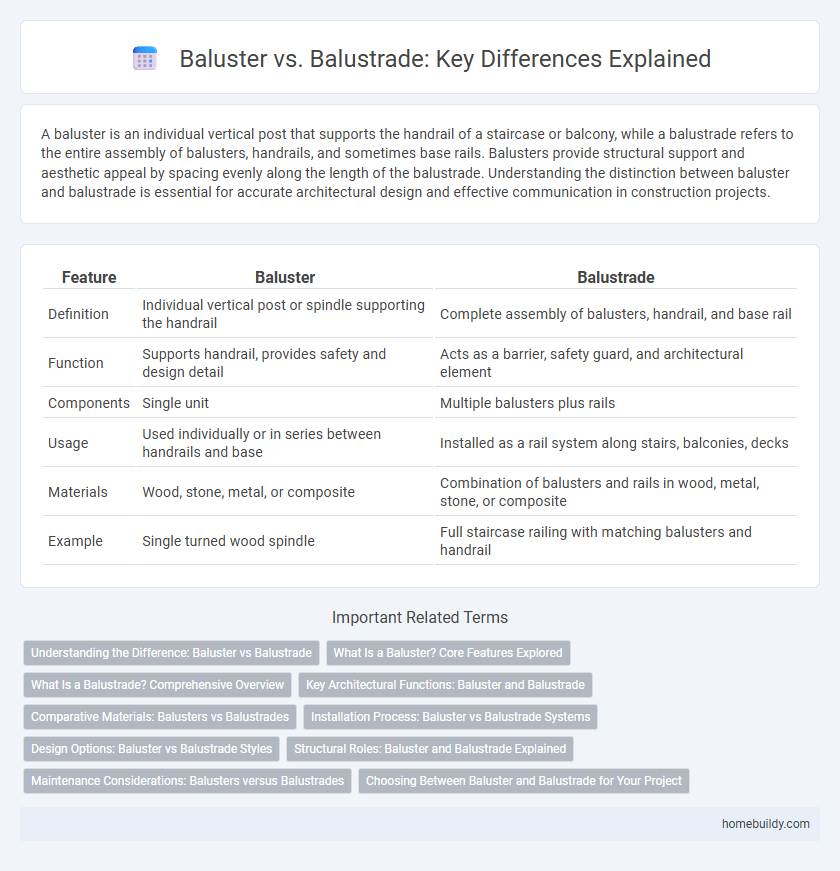A baluster is an individual vertical post that supports the handrail of a staircase or balcony, while a balustrade refers to the entire assembly of balusters, handrails, and sometimes base rails. Balusters provide structural support and aesthetic appeal by spacing evenly along the length of the balustrade. Understanding the distinction between baluster and balustrade is essential for accurate architectural design and effective communication in construction projects.
Table of Comparison
| Feature | Baluster | Balustrade |
|---|---|---|
| Definition | Individual vertical post or spindle supporting the handrail | Complete assembly of balusters, handrail, and base rail |
| Function | Supports handrail, provides safety and design detail | Acts as a barrier, safety guard, and architectural element |
| Components | Single unit | Multiple balusters plus rails |
| Usage | Used individually or in series between handrails and base | Installed as a rail system along stairs, balconies, decks |
| Materials | Wood, stone, metal, or composite | Combination of balusters and rails in wood, metal, stone, or composite |
| Example | Single turned wood spindle | Full staircase railing with matching balusters and handrail |
Understanding the Difference: Baluster vs Balustrade
A baluster is a single vertical post that supports the handrail of a staircase or balcony, whereas a balustrade is the entire assembly including the handrail, balusters, and often a base rail or panel. Balusters are typically crafted from wood, metal, or stone, and serve both structural and decorative purposes. Understanding this distinction helps in accurately referring to components in architectural design and construction.
What Is a Baluster? Core Features Explored
A baluster is a vertical, often decorative post that supports the handrail of a staircase or balcony, forming the essential component of a balustrade. Typically made from materials like wood, metal, or stone, balusters vary in design, ranging from simple spindles to intricately carved shapes, providing both structural support and aesthetic appeal. The balustrade, in contrast, refers to the complete assembly of balusters, handrail, and sometimes a base rail, functioning collectively as a safety barrier and architectural feature.
What Is a Balustrade? Comprehensive Overview
A balustrade is an architectural feature consisting of a series of balusters supporting a handrail, often found on stairs, balconies, or terraces. Unlike a baluster, which refers to the individual vertical posts, the balustrade encompasses the entire assembly, including the handrail, balusters, and base rail. This cohesive structure provides both safety and aesthetic appeal in architectural design.
Key Architectural Functions: Baluster and Balustrade
A baluster is a single vertical post that supports the handrail of a staircase or balcony, serving both structural and decorative purposes. A balustrade is the complete assembly of multiple balusters, handrails, and sometimes a base rail, providing safety and defining the boundary of stairs, terraces, or balconies. Key architectural functions of balusters include load-bearing and aesthetic enhancement, while the balustrade ensures overall stability, safety, and cohesive design integration.
Comparative Materials: Balusters vs Balustrades
Balusters are individual vertical posts typically made from wood, metal, stone, or composite materials, designed to support the handrail of a staircase or balcony. Balustrades consist of a series of balusters connected by a handrail and base rail, often constructed from similar materials but with added design elements for structural integrity and aesthetic continuity. While balusters focus on detailed craftsmanship and material variety, balustrades emphasize overall stability and cohesion in architectural applications.
Installation Process: Baluster vs Balustrade Systems
The installation process of balusters involves individually setting vertical posts into handrails or stair treads, requiring precise measurements and secure anchoring for stability. In contrast, balustrade systems are installed as pre-assembled units or modular sections, streamlining construction by reducing on-site labor and aligning components for uniform spacing and aesthetics. Understanding the distinction in installation complexity helps in selecting the appropriate system for efficient construction and desired design outcomes.
Design Options: Baluster vs Balustrade Styles
Baluster design options range from classic turned wood to modern metal and glass styles, providing versatile individual elements that support handrails. Balustrade styles encompass the entire railing system, combining multiple balusters with newel posts and handrails to create cohesive architectural statements. Selecting between baluster designs focuses on texture and detail, while balustrade styles emphasize the overall structural and aesthetic unity in staircases and balconies.
Structural Roles: Baluster and Balustrade Explained
A baluster is a single vertical post or spindle that supports the handrail of a staircase or balcony, serving as a key structural element for safety and stability. In contrast, a balustrade refers to the complete assembly of multiple balusters, along with the top rail and base rail, functioning as a protective barrier and architectural feature. Understanding the distinction between balusters and balustrades clarifies their roles in distributing loads and providing support in staircases, terraces, and parapets.
Maintenance Considerations: Balusters versus Balustrades
Balusters require individual inspection and cleaning to prevent damage and maintain aesthetic appeal, often demanding more detailed attention due to their smaller and more intricate design. Balustrades, as complete railing systems, allow for easier maintenance through consolidated cleaning and repair of connected components. Choosing between balusters and balustrades for a project should factor in the frequency and complexity of upkeep alongside durability and design preferences.
Choosing Between Baluster and Balustrade for Your Project
Choosing between a baluster and a balustrade depends on the scope and purpose of your project, as balusters are individual posts that support the handrail, while a balustrade is the complete assembly including balusters, handrails, and sometimes base rails. For detailed architectural features or small sections, selecting high-quality balusters with specific materials like wood or wrought iron enhances aesthetic appeal. Large-scale installations benefit from designing a cohesive balustrade system for safety compliance and structural integrity.
baluster vs balustrade Infographic

 homebuildy.com
homebuildy.com